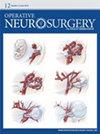未破裂和破裂脑动脉瘤的开放显微手术与血管内治疗。
IF 1.7
4区 医学
Q3 CLINICAL NEUROLOGY
引用次数: 0
摘要
开放显微外科手术和血管内技术是治疗颅内动脉瘤的两种主要方法。显微外科剪切和辅助技术操作是成熟的技术,具有高闭塞率和持久修复的记录。血管内、肌内和肌外疗法的围手术期发病率较低,但再治疗率通常较高。我们将讨论治疗决策中的关键临床和解剖考虑因素,并比较显微外科治疗和血管内治疗在不同情况下的风险和益处。本文章由计算机程序翻译,如有差异,请以英文原文为准。
Open Microsurgical Versus Endovascular Management of Unruptured and Ruptured Brain Aneurysms.
Open microsurgical and endovascular techniques are the 2 primary strategies for treating intracranial aneurysms. Microsurgical clipping and adjuvant technical maneuvers are well-established techniques with a track record for high occlusion rates and durable repairs. Endovascular, endosaccular, and extrasaccular therapies are associated with lower peri-procedural morbidity but with generally higher rates of retreatment. We discuss key clinical and anatomic considerations in treatment decision-making and compare the risks and benefits of microsurgical vs endovascular treatment within each context.
求助全文
通过发布文献求助,成功后即可免费获取论文全文。
去求助
来源期刊

Operative Neurosurgery
Medicine-Neurology (clinical)
CiteScore
3.10
自引率
13.00%
发文量
530
期刊介绍:
Operative Neurosurgery is a bi-monthly, unique publication focusing exclusively on surgical technique and devices, providing practical, skill-enhancing guidance to its readers. Complementing the clinical and research studies published in Neurosurgery, Operative Neurosurgery brings the reader technical material that highlights operative procedures, anatomy, instrumentation, devices, and technology. Operative Neurosurgery is the practical resource for cutting-edge material that brings the surgeon the most up to date literature on operative practice and technique
 求助内容:
求助内容: 应助结果提醒方式:
应助结果提醒方式:


